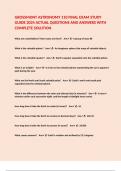What is an ecliptic - Study guides, Class notes & Summaries
Looking for the best study guides, study notes and summaries about What is an ecliptic? On this page you'll find 72 study documents about What is an ecliptic.
Page 2 out of 72 results
Sort by
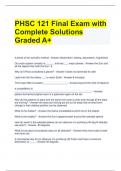
-
PHSC 121 Final Exam with Complete Solutions Graded A+
- Exam (elaborations) • 5 pages • 2024
-
Available in package deal
-
- $11.99
- + learn more
PHSC 121 Final Exam with Complete Solutions Graded A+ 4 points of the scientific method - Answer-observation, testing, assumption, hypothesis Our solar system consists of ______ and has ___ major planets - Answer-the Sun and all the objects that orbit the Sun / 8 Why isn't Pluto considered a planet? - Answer-It does not dominate its orbit Light from the Sun takes ___ to reach Earth - Answer-8 minutess The Kuiper Belt is located __________________ - Answer-beyond the orbit of Nept...
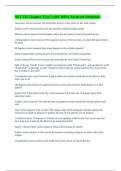
-
AST 111 Chapter Two || with 100% Accurate Solutions.
- Exam (elaborations) • 4 pages • 2024
-
- $10.29
- + learn more
Geocentric correct answers The belief that Earth is at the center of the solar system Zenith correct answers point in the sky directly overhead; highest point Horizon correct answers The boundary where the sky seems to meet the ground or sea celestial sphere correct answers The apparent surface of the heavens, on which the stars seem to be fixed 90 degrees correct answers How many degrees is the celestial equator? North Celestial Pole correct answers the point directly over Earth...
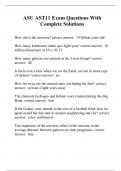
-
ASU AST11 Exam Questions With Complete Solutions
- Exam (elaborations) • 21 pages • 2023
-
- $12.99
- + learn more
How old is the universe? correct answer: 14 billion years old How many kilometers make up a light year? correct answer: 10 trillion kilometers or 10 x 10^12 How many galaxies are present in the Local Group? correct answer: 40 Is there ever a time when we, on the Earth, are not in some type of motion? correct answer: no How far away are the nearest stars, excluding the Sun? correct answer: at least 4 light years away The elements hydrogen and helium were created during the Big...
GROSSMONT ASTRONOMY 110 FINAL EXAM STUDY GUIDE 2024 ACTUAL QUESTIONS AND ANSWERS WITH COMPLETE SOLUTION
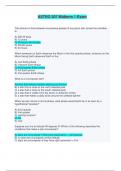
-
ASTRO 207 Midterm 1 Exam - Questions with Verified Answers
- Exam (elaborations) • 11 pages • 2024
-
- $16.99
- + learn more
ASTRO 207 Midterm 1 Exam - Questions with Verified Answers The amount of time between successive passes of any given star across the meridian is: A) 365.25 days B) 12 years C) 23 hours, 56 minutes D) 26,000 years E) 24 hours When someone on Earth observes the Moon in the first-quarter phase, someone on the Moon facing Earth observes Earth in the: A) new Earth phase B) crescent Earth phase C) third-quarter Earth phase D) full Earth phase E) first-quarter Earth phase What is a circumpolar star? ...
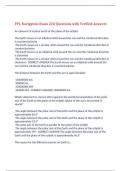
-
PPL Navigation Exam 224 Questions with Verified Answers,100% CORRECT
- Exam (elaborations) • 54 pages • 2024
-
Available in package deal
-
- $12.99
- + learn more
PPL Navigation Exam 224 Questions with Verified Answers An observer is located north of the plane of the ecliptic The Earth moves on an elliptical orbit around the sun and the rotational direction is counterclockwise The Earth moves on a circular orbit around the sun and the rotational direction is counterclockwise The Earth moves on an elliptical orbit around the sun and the rotational direction is clockwise The Earth moves on a circular orbit around the sun and the rotational direc...
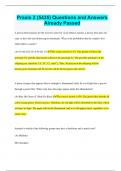
-
Praxis 2 (5435) Questions and Answers Already Passed
- Exam (elaborations) • 12 pages • 2024
- Available in package deal
-
- $9.99
- + learn more
Praxis 2 (5435) Questions and Answers Already Passed A person heterozygous for the recessive gene for cystic fibrosis marries a person who does not carry or have the trait (homozygous dominant). What is the probability that the couple's first child will be a carrier? (A) 0.0 (B) 0.25 (C) 0.50 (D) 1.0 The correct answer is (C). One parent will have the genotype CC and the other parent will have the genotype Cc. The possible genotypes of the offspring are, therefore, CC, CC, Cc, and ...
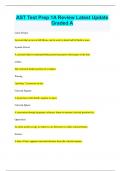
-
AST Test Prep 1A Review Latest Update Graded A
- Exam (elaborations) • 21 pages • 2023
- Available in package deal
-
- $9.49
- + learn more
AST Test Prep 1A Review Latest Update Graded A Lunar Eclipse An event that occurs at full Moon, can be seen by about half of Earth at once. Synodic Period A celestial object's rotational/orbital period measured with respect to the Sun. Umbra The central & darkest portion of a shadow Waxing "growing." to increase in size Celestial Equator A projection of the Earth's equator to space Celestial Sphere A convenient though imaginary reference frame to measure celestial positions by. Opposi...
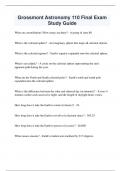
-
Grossmont Astronomy 110 Final Exam Study Guide
- Exam (elaborations) • 21 pages • 2024
-
Available in package deal
-
- $13.99
- + learn more
What are constellations? How many are there? - A group of stars.88 What is the celestial sphere? - An imaginary sphere that maps all celestial objects. What is the celestial equator? - Earth's equator expanded onto the celestial sphere. What is an ecliptic? - A circle on the celestial sphere representing the sun's apparent path during the year. What are the North and South celestial poles? - Earth's north and south pole expanded onto the celestial sphere. What is the difference...
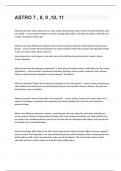
-
ASTRO 7 , 8, 9 ,10, 11 questions with answers 2024
- Exam (elaborations) • 7 pages • 2024
-
- $12.99
- + learn more
ASTRO 7 , 8, 9 ,10, 11What are the four major features of our solar system that provide clues to how it formed? Describe each one briefly. - correct answer Patterns of motion among large bodies, Two types of planets, asteroids and comets, exceptions to the rules. What are the basic differences between the terrestrial and jovian planets? Which planets fall into each group? - correct answer Terrestrial planets are small and dense with rocky surfaces and abundant metals in the core: Earth, Mars,...

Do you wonder why so many students wear nice clothes, have money to spare and enjoy tons of free time? Well, they sell on Stuvia! Imagine your study notes being downloaded a dozen times for $15 each. Every. Single. Day. Discover all about earning on Stuvia

